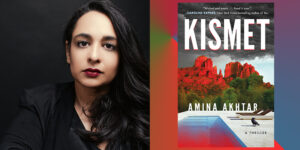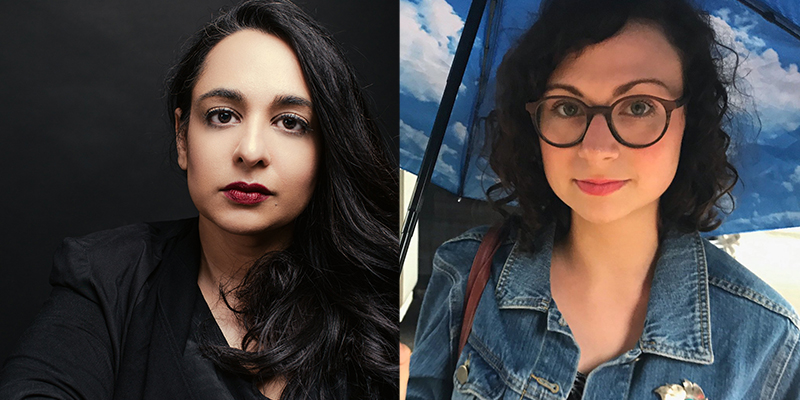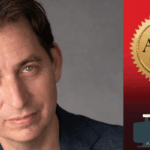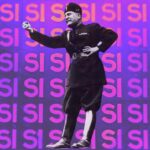Amina Akhtar and Erin Mayer have had fashion and media careers that people dream about. Between them, they’ve worked at every major publication, including Vogue, The Cut, Elle, Bustle, NYTimes.com and more. But they both also made the leap from fashion/celebrity editor to thriller writer. We had to know more!
The author of Fan Club and the author of Kismet (out 8/1) interviewed each other to talk about their experiences, and why, exactly, fashion inspires so much rage.

Questions from Amina Akhtar:
What’s your fashion/media background?
Erin Mayer: I have been working in media since 2014. I’ve freelanced for a variety of publications, and was previously an Associate Fashion and Beauty Editor at Bustle.com.
Amina Akhtar: I feel like we all always have so many publications we can list off! I started at Vogue, went digital, worked at Style.com (RIP!), NYTimes.com, and then helped launch The Cut blog for NYMAG. Also worked at Elle.com and Vogue.com.
What made you decide to write a thriller?
EM: It sort of happened by accident! I have always loved crime fiction and horror, so my fiction writing is naturally infused with dread, but initially I thought I was going to write a more typical “millennial workplace novel.” Once I settled on the plot also being about celebrity obsession (Fan Club follows a disgruntled 20-something woman who fixates on an international pop star and falls in with a cult-like group of superfans) it dove-tailed with, well, murder.
AA: Same with me. I didn’t set out thinking I’m now going to be a thriller writer. I just thought it would be funny to write a book about a serial killer in fashion. And to be honest, I wasn’t doing much. I was in a low point and I needed to refocus myself. I rediscovered my love of writing. And the rest is history.
In Fan Club, you dive into celebrity culture and also the banality of working at lifestyle media sites. First, I have to know, have you ever joined a fan club yourself?
EM: While writing, I channeled the experience of loving the emo band My Chemical Romance as a teenager. That was the closest I came to a similar all-encompassing obsession that my narrator experiences. Even though the characters in my book are young adults and not adolescents, I was conscious of the fact that fixation on celebrity doesn’t vanish the minute you turn eighteen. Adults are by and large the creators and consumers of tabloids and gossip websites. But for the scenes where my narrator is spending time with “the Ivies” (the name of the fandom in the book) I reflected on the memories of going to concerts with my best friends or watching videos and documentaries about our favorite bands in high school. My novel is critical of celebrity worship and fan culture, but I wrote the story from a place of compassion and understanding. Some of my closest friendships to this day were born of a shared love of a particular band’s music.
And second, how much of your take on celebrity worship was pulled from your real life/career?
EM: I thought about the breathless coverage of celebrities we’re constantly exposed to, and especially considered the way that many websites report on celebrities when they die, which feels especially exploitative and vulture-y. If it looks like a celebrity’s health has taken a turn for the worse, publications will often prepare a news story announcing their death in advance. Though I don’t reference that specifically in the novel, it informed the way I thought about the media’s relationship to famous people. Websites and magazines are used as celebrity PR machines in some ways, publishing fluffy profiles, but these same publications often invade the privacy of those in the public eye and treat them brutally.
AA: I never joined a fan club because I’m not a joiner BUT celeb worship is always a fun topic to explore. Our culture is so obsessed with celebrities, that of course we would want to write thrillers around them.
Do you often feel there’s a regressed aging happening in lifestyle media? Like we’re all perpetually in high school?
“It did feel like we had arrested development in fashion, because it’s an industry that encourages you to behave poorly.” –Erin MayerEM: Totally. Some of it feels very infantilizing—I’m thinking about the era in the early-to-mid 2010s where every celebrity who dared to, like, have a body in public was labeled “body positive” and there were constant blog posts (some of which I wrote and edited myself) about various Kardashian/Jenners posing “no-makeup-makeup” selfies. I think there’s been some push-back against that kind of tone in recent years, but it still exists.
AA: I likened it to high school in #FashionVictim. You had the cool girls–the market editors who would be front row and wearing the newest and best designs. You had the band geeks which were like the fact checkers and copyeditors. And somewhere in there was the digital team, who were like the student body president and co. It did feel like we had arrested development in fashion, because it’s an industry that encourages you to behave poorly. And all that seemed to matter to anyone was what you looked like.
I found that when I was writing FashionVictim, I had a lot of pent up rage inside me. Kind of like now, with everything that’s happening. How did you channel that fury into your writing?
EM: I am so angry all the time about the state of the world, and it certainly informs my work. I think that’s part of why I write a lot about toxic white feminism, which is super pervasive in these spaces that claim to be progressive and radical because they are run by women, yet they continue to perpetuate harm (like both the women’s website and the fan club in my debut). I have a lot of fun writing over-the-top violence and using hints of body horror in my work, which is another way I channel it.
AA: I’m weirdly less angry now? I think working in an industry that very much doesn’t want you–i.e., they want white, thin, tall women with trustfunds–can make a person angry. And getting away from all of that has done wonders for me. FV was definitely very cathartic for me to write. I definitely had certain people in mind for the murders.
How—if at all—did your fashion background prepare you for the world of book publishing?
EM: The industries are very different—digital fashion media is fast-paced and all about the now, while book publishing is slow. I wrote my debut novel in 2019, sold it in 2020, and it was released near the end of 2021. But I think working in fashion media prepared me for rejection and the editorial process in general. I learned not to take those things personally, because it’s all just business and about making the writing as strong as possible.
AA: Yeah, if anything, being in that world definitely helped with rejection, but also prepared me for any success, in that it doesn’t go to my head. I think being near celebs and top editors so much really helped me understand there’s a difference between people who love your work and who love you. And that’s really important to know. Not everyone who is around you is a friend, and it’s key to know the difference.
I find that because of writing on quick digital deadlines, I write fast. But not in depth. I’ve had to work on that. How has your writing style/progress changed?
EM: Working for websites helped me learn how to let go of my perfectionism a little bit and write more quickly. Since it’s so fast-paced, there’s no time to obsess over every single word. Without that skill, I’m not sure I ever would have finished the first draft of my debut. However, I did have to re-learn how to take my time and indulge in my obsessions and fascinations, and allow myself to really luxuriate over certain images or themes, when I began writing fiction seriously. Online writing, be it a news story or a personal essay, is all about immediacy. But in fiction there’s a lot more room to play.
AA: There’s no time to obsess! We have to churn content out. And in a way, that’s helpful when writing novels because I don’t think about it that much in the first draft. It’s when I go over and over the words, adding to them, making them more interesting and layered, that I feel the difference between the two styles so keenly.
I always joke that you couldn’t pay me enough to go back to fashion. What about you?
EM: When I was growing up, I truly believed that my dream was to write novels while also somehow becoming a high-powered editor at Vogue (ha). Now I am so glad I get to work at home in sweatpants most days.
AA: Seriously, nope. Not happening. I never like saying never, but never.
What is it about the fashion world that leads us to want to write crazy thrillers?
EM: For me, it’s a lot about the toxicity of the fashion and beauty industries and how they sell this impossible thin, white “ideal” that is extremely damaging to girls and women, especially, but also to everyone else. Both my debut and my current project deal with a sort of weaponized femininity and how it creates an ouroboros of insecurity and lashing out. In Fan Club this manifests through the main character’s ultimately destructive fixation on a major celebrity with a seemingly perfect life. My current work-in-progress is about the beauty industry and the relentless pursuit of longer-lasting youth.
AA: Ooooh, I can’t wait for your next one! I think the fashion and beauty worlds are so ripe for thrillers. Really, a thriller could be set in any world and work. But it’s just so much fun in fashion and beauty. Kismet is wellness, which is fashion-adjacent. But also, fashion is a world of appearances, where the prettier you are, the better you are. Who wouldn’t want to tear that down?
Is there any fashion editor/writer who you’d like to see write a thriller?
EM: The absolute unrealistic dream for me is that Anna Wintour would pivot to writing glamorous fashion industry thrillers.
AA: I think Sally Singer, a former top editor at Vogue, would have some good plots to write. I’d love to see her write one. And Robin Givhan because she’s just the most brilliant fashion critic ever.

Questions from Erin Mayer:
Did you always know you wanted to write fiction or did your time working in fashion media lead you down this path?
EM: Yes, yes! I’ve wanted to write novels since I was about eight years old, when I first realized that it was an actual job.
AA: I always wanted to write. But for some reason I had it in my head that I wasn’t a writer-writer. As in, I didn’t write novels. That was reserved for people who got MFAs. So I never really considered it. I did my blog posts, edited things, and felt envious and amazed when anyone I knew wrote a book. Every now and then I’d try to write a book and it didn’t work. But in 2014 or so, I had been laid off from Elle as the industry started imploding. And I wasn’t doing anything and had no idea what to do with myself. So I wrote FV. And I don’t think I’d have gotten there had I not gone through the fashion industry and that lay off.
“I used to wear two pairs of spanx a day at work, and eat a sad salad for lunch. If that doesn’t inspire rage, what will?” –Amina AkhtarBoth of our debut novels deal with the violent side of the “glamorous” media industry—what about fashion magazines/websites makes them a great setting for themes of female rage?
EM: There is something enraging about beauty standards, isn’t there? While I do believe that fashion media is getting better all the time as far as representation goes, the industry was not built on inclusivity. My characters are dealing with the repression, anxiety, and anger that comes from trying to fit yourself into an impossible mold.
AA: I used to wear two pairs of spanx a day at work, and eat a sad salad for lunch. If that doesn’t inspire rage, what will?
Would you like to say a bit about what you’re working on now and how it relates/doesn’t relate to the fashion world?
EM: My new book is set in the beauty industry, so in some ways it’s even more focused on the themes we’ve discussed here than my debut is. I was inspired by American Psycho and stylized horror films like the original Suspiria and In Fabric.
AA: Kismet (out Aug 1) is set in Sedona but dives into the white world of wellness. Think Goop and all its followers and crystals, but with murder and talking ravens. It’s weird! Like me! I think wellness goes hand in hand with beauty and fashion. There were tons of weird diets and crystal moments that I had back then.
***


















